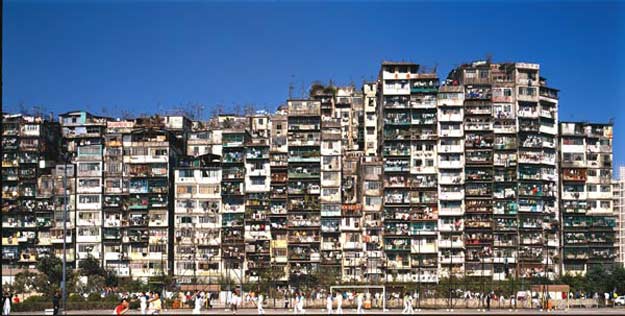Hong Kong Walls of Density and Light
 Alphachimp
Alphachimp  Saturday, April 2, 2005 at 6:54PM
Saturday, April 2, 2005 at 6:54PM Hong Kong's population has increased steadily over the past decade, reaching about 7.1 million by 2000.The population density with respect to built-up area would be even much more higher, since only a small proportion of land are developed. Despite the population density, Hong Kong was reported to be one of the greenest cities in Asia. The majority of people live on flats in high-rise buildings. The rest of the open spaces are often covered with parks, woods and shrubs. The vertical placement of the population explains why densely populated, green city is not an oxymoronic phrase.
~ Answers.com
Hong Kong is one of the most densely populated areas in the world, with an overall density of some 6,300 people per square kilometre. Two photographers capture that density, in saturated, rich photographs:
Architecture of Density | Michael Wolf
One of the most densely populated metropolitan areas in the world, Hong Kong has an overall density of nearly 6,700 people per square kilometer. The majority of its citizens live in flats in high-rise buildings. In Architecture of Density, Wolf investigates these vibrant city blocks, finding a mesmerizing abstraction in the buildings' facades.
Some of the structures in the series are photographed without reference to the context of sky or ground, and many buildings are seen in a state of repair or construction: their walls covered with a grid of scaffolding or the soft colored curtains that protect the streets below from falling debris. From a distance, such elements become a part of the photograph's intricate design.
~ from www.photomichaelwolf.com
[via Z+ Partners]
City of Darkness | Ian Lambot
Hak Nam, the old Walled City of Kowloon was finally demolished over ten years ago, in 1993, and to the end it retained its seedy magnificence.
The Kowloon Walled City was a garrison town built by the Qing government as a military outpost in 1847 [see history].
During the Japanese occupation in 1942-45 the walls were torn and the stone was used to expand the nearby Kai Tak Airport. Following the end of WWII hundreds of thousands of migrants from China turned this area into a slum. In 1987, it was announced the Walled City would be cleared and replaced with a park. The park is built in the classical Jiangnan style and its features include a Garden of the Chinese Zodiac, a Mountain View Pavilion and a Hill Top Pavilion [see photos].
Surrounded now only by walls of political inhibition, the City became the place where they could get their breath back; where they could live as Chinese among other Chinese, untaxed, uncounted and untormented by governments of any kind.
And so, the Walled City became that rarest of things, a working model of an anarchist society. Inevitably, it bred all the vices. Crime flourished and the Triads made the place their stronghold, operating brothels and opium ‘divans’ and gambling dens. Undoubtedly, these few (and it always was a small proportion) kept the majority of residents in a state of fear and subjection, which is why for many years outsiders trying to penetrate were given the coldest of shoulders.
~from www.arch.columbia.edu
(via Owen Mack of OBTTV)







Reader Comments